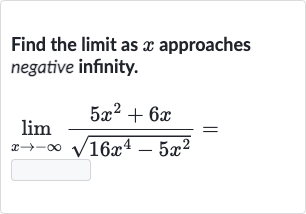AI tutor
Full solution
Q. Find the limit as approaches negative infinity.
- Divide by : To find the limit of the given function as approaches negative infinity, we need to analyze the behavior of the numerator and the denominator separately. We will start by simplifying the expression by dividing both the numerator and the denominator by the highest power of in the denominator, which is .
- Simplify expression: Divide the numerator and the denominator by : Simplify the expression:
- Remove terms: As approaches negative infinity, the term in the numerator approaches , and the term in the denominator also approaches . Therefore, we can simplify the expression further by removing these terms:
- Simplify square root: Now, we can simplify the square root in the denominator by taking out of the square root, which gives us (the absolute value of ). Since we are considering the limit as approaches negative infinity, will be equal to (because is negative and the absolute value makes it positive):
- Multiply by : Simplify the expression by multiplying the numerator by (since we are dividing by ):As approaches negative infinity, approaches . Therefore, the limit of the entire expression as approaches negative infinity is:

